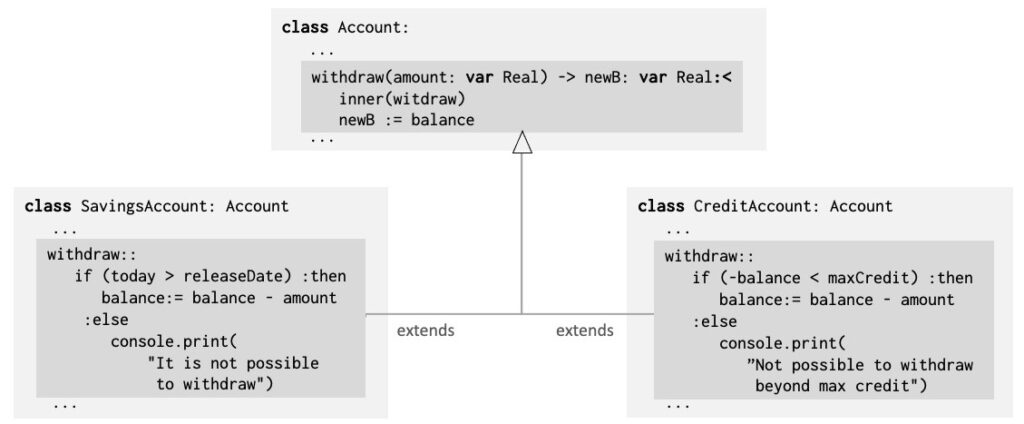In this section, we will introduce virtual methods. Virtual methods may be used to specify partial methods that may be further extended in subclasses.
In the next example, we define withdraw of Account as a virtual method:
class Account(owner: ref Customer):
...
witdraw(amount: var float) -> newB: var float:<
inner(witdraw)
newB := balanceThe symbol ':<' specifies that withdraw is a virtual method.
The statement part of withdraw consists of inner followed by newB := balance.
The statement inner specifies that when executed, possible statements in a further extension of withdraw in a subclass of Account will be executed.
In the next example, we show how to extend withdraw in a class SavingsAccount:
class SavingsAccount: Account
...
withdraw ::
if (today > releaseDate) :then
balance:= balance - amount
:else
console.print("It is not possible to withdraw")The symbol '::' specifies that withdraw is an extension of withdraw in the superclass Account of SavingsAccount.

In the following example, we invoke withdraw on a SavingsAccount:
aSavingsAccount: obj SavingsAccount(JonhSmith)
newBalance: var float
newBalance := aSavingsAccount.withdraw(340)Execution of aSavingsAccount.withdraw(340) takes place as follows:
- Execution starts by execution of the statements in
withdrawas defined inAccount. - The first statement to execute is
inner. - Execution of
innerimplies that the statements of withdraw inSavingsAccountare executed. - When the statements in
SavingsAccounthave been executed, control returns to the statements afterinnerinAccount. - This implies that
newB := balanceis executed - Finally execution of
withdrawis completed.
The figure below illustrates the execution of aSavingsAccount.withdraw(340). The numbers show the order of execution of the involved statements:

We may extend withdraw in a similar way in CreditAccount:
class CreditAccount: Account
...
withdraw ::
if (-balance < maxCredit) :then
balance := balance - amount
:else
console.print("Not possible to withdraw beyond max credit") Invocation of withdraw on a CreditAccount object implies that execution of inner will execute the statements in withdraw in SavingsAccount.
A virtual print method
We now add one more virtual method to Account and its subclasses in the form of a print method that prints the status of a given account on the console.
Part of the print of status is the same for all accounts whereas other parts are special for the subclasses.
class Account(owner: ref Customer):
...
createStatement:<
stmt: var String
stmt := "Account statement for " + owner.name + '\n'
+ "The account is a "
inner(Account)
stmt := stmt + "The balance is: " + balance + '\n'
print:
console.print(createStatement)
sendEmail:
owner.email(createStatement)
class SavingsAccount: Account
...
createStatement::
stmt := stmt + "savings account." +
"\nRelease date is " + releaseDate.asText